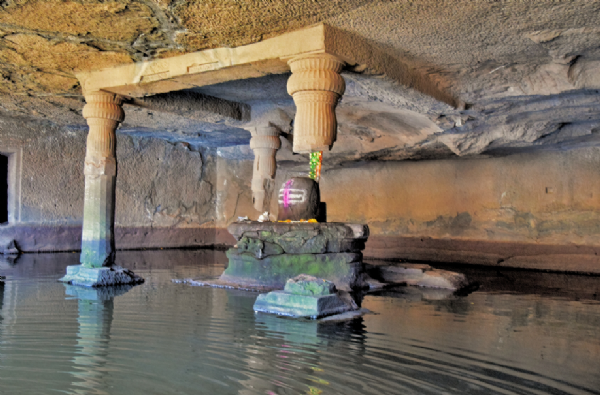Mystery of Kedareshwar cave temple, marking Kalyug’s end
18 Jul 2022 17:04:39
There are numerous unresolved and hidden secrets in India’s ancient history that are well beyond the human mind’s comprehension, as even after trying to decipher them for centuries, they still remain to be unresolved. The Kedareshwar cave, which is located near Harishchandragad, in Ahmednagar, Maharashtra, is one such mystery.

The Saptatirtha Pushkarni, alternatively known as the Seven Waters, is located on the eastern part of the temple and is actually known for its medicinal abilities. This river called as Mangal Ganga, is said to have its source in the water reservoirs that are surrounding the temple. There are many points of interest here, and one can truly appreciate the tranquillity & worn pebbles and breath-taking view from this lovely point.
Only one of the four pillars that once surrounded the Linga still stands in its complete, original form. It is believed the pillars Satya, Tretha, Dwapara, and the Kali Yuga, are emblems of yugas or the periods of time. A pillar is believed to break off at the end of each yuga. The current pillar is thought to represent the Kali Yug, which is the very last yuga. As a result, there is a belief that the world would end when the final and surviving pillar breaks.
Our advise would be to is to visit the place to seek peace of mind & expecrience natural zest at the Kedareshwar Cave. In no way will the visit disappoint you.

The iconic place of Harishchandragad is located in Malshej Ghat in the district of Ahmednagar at an altitude of 4,670 feet. Harishchandragad happens to be home of the Kedareshwar Cave Temple. The fort is also a very popular trekking destination.
The Kedareshwar temple is truly unlike any other temple you would have ever visited. The temple’s location being inside a cave, along with it being in the presence of water all through the year, makes it one of the mo st unusual and unique temples not only in Maharashtra but the entire country.
This temple carved from a monolithic structure has unique sculptures and an inscription done by Rishi Changdev in the Devanagari script. The carvings inside this temple and in Kedareshwar cave suggest that the fort belongs to the medieval period which is also in resemblance with the style of architecture.
The temple was built in the Hemadpanti style of architecture and is dedicated to Harishchandreshwar. According to locals there, the Kalachuri dynasty built this fort back in the 6th century, but the Harishchandragad Fort caverns were dug out in the 11th century. The carvings at the fort, as well as the many structures in the surrounding areas, signs suggest the presence of diverse cultures to have resided there.
In the cave’s centre is a Shiva Linga that is about five feet tall. To get to the Shiva Linga, one has to wade or swim through waist-deep and truly ice-cold water. Locals say that this cave is mostly inaccessible in the monsoon because of a huge stream that flows across the way. Another interesting point is that water seeps into this temple every day through the four walls.
Our advise would be to is to visit the place to seek peace of mind & expecrience natural zest at the Kedareshwar Cave. In no way will the visit disappoint you.
